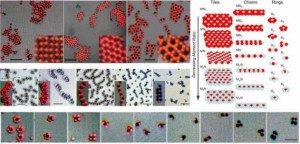Binary Colloidal Structures Assembled through Ising Interactions

The diverse functionality of crystalline materials found in nature has inspired the quest to develop man-made versions with building blocks ranging in size from atoms to bricks. Self-assembly of microscopic particles into macroscopic structures provides a robust pathway for building 2D and 3D crystalline materials that cannot be produced by lithographic methods; however a general pathway for producing a wider variety of structures remains a fundamental challenge. Researchers at University of Michigan – Shanghai Jiao Tong University Joint Institute, Shanghai, China, in collaboration with colleagues at Duke University, Durham, NC, reported a breakthrough in this week’s edition of Nature Communications on a versatile colloidal assembly system, in which the design rules can be tuned to yield over 20 different pre-programmed structures, including Kagome, honeycomb, square tiles, and various chain and ring configurations.
The assembled structures are tuned by controlling the relative concentrations and interaction strengths between spherical magnetic and non-magnetic beads, which behave as paramagnetic or diamagnetic dipoles when immersed in a ferrofluid. When this mixture of beads are immersed in a ferrofluid, the unlike particles attract and the like particles repel in a manner similar to the attraction and repulsion between positive and negative charges. The director of the research, Prof. Yellen, described this process using the analogy, “Conceptually, the role of the ferrofluid is to adjust the effective charges on the different beads, and coax them to form structures that resemble the NaCl lattice as well as others that are not found in nature.” Despite the resemblance to electric charges, the analogy is not exact. Yellen remarks “Compared with ionic systems which are limited to charges of integer number, the magnetic dipoles are not perfectly compensated, and thus we can also produce frustrated lattices, such as various chain and ring states.”
In addition to the experiments, Prof. Yellen and his group developed theoretical models that can predict the assembled structure as a function of the experimental parameters. Yellen explains, “The beauty of this technique is that we can select the type of crystal that forms by choosing the right concentrations of particles and ferrofluid. It turns out that the phase behavior of the assembled structures can be predicted with a simple theory based on two tuning parameters, namely, by the relative particle dipole moments and their relative concentrations. The agreement between theory and experiment is quite remarkable.” Yellen anticipates that by using particles of different sizes, shapes, and types, it is possible to assemble a more diverse set of crystal structures that not only have myriad of applications, but also can provide fundamental insights into how crystals form at the atomic scale. This work was supported by a NSFC Young Foreign Scholar Award.





